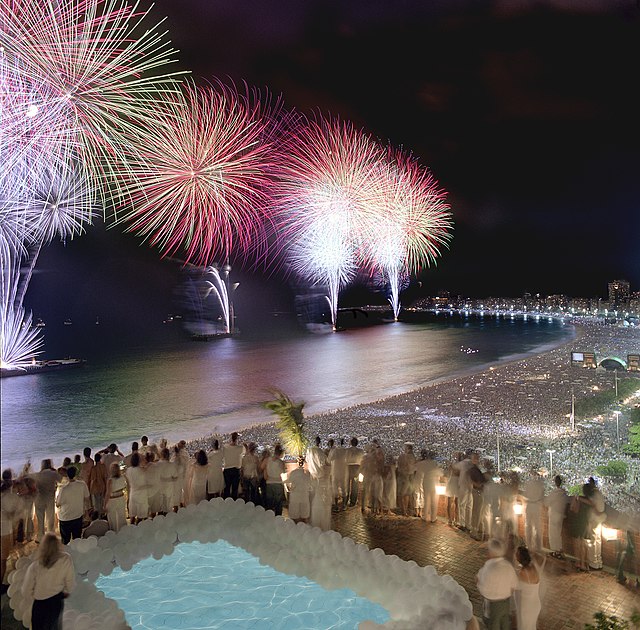Top Qs
Timeline
Chat
Perspective
New Year's Eve in Copacabana
Annual celebration in Brazil From Wikipedia, the free encyclopedia
Remove ads
New Year's Eve in Copacabana or Réveillon in Cobacabana is the largest New Year's celebration in the world, taking place from December 31 to January 1 on Copacabana Beach, located in Rio de Janeiro.[1] The event features a fireworks display lasting around 12 minutes, along with performances by various artists, currently attracting around two million people.[2][3]

The word réveillon originates from the French verb réveiller, which means "to wake up." Thus, réveillon symbolizes the awakening of the new year.
Remove ads
History
Summarize
Perspective
Those who began celebrating New Year's Eve on Copacabana Beach were Candomblé practitioners in the 1970s. The event was smaller in scale, and everyone wore white to honor Iemanjá, offering gifts to the sea before midnight.[4]
The practice of wearing white clothing and offering flowers to the sea became part of the New Year's tradition, not only in Rio de Janeiro but throughout Brazil. According to Candomblé, the color white is used to symbolize mourning for death, which allows for rebirth and the continuation of life.[5][6]
1980s
The tradition of fireworks during New Year's in Copacabana was started by Mario, the owner of the former By Marius steakhouse, in 1978. He gathered local merchants from Leme to raise funds for the fireworks display. In the 1980s, the former Meridien Hotel (located at the corner of Princess Isabel Avenue) introduced its iconic firework waterfall, which marked the end of the display. The 39-story building featured a cascade of fireworks that began at the top and gradually descended down the skyscraper.[7]

Thus, other hotels began to fund the fireworks display, attracting both tourists and locals. As the event grew, the city of Rio de Janeiro had to prioritize the safety of those attending the New Year's celebration in Copacabana. Following a serious accident on the beach, the fireworks were moved to barges out at sea. To prevent crowding after the fireworks show, the city began organizing beach concerts in 1993, ensuring people wouldn't all leave at once. Performances by Jorge Ben and Tim Maia helped ease the flow of the crowd.[8]
Following this highly successful experience of New Year's Eve concerts, the city government registered the event as official, bringing various attractions to the Copacabana stages every year.[9]
Remove ads
Record
In 1993, Jorge Ben Jor attracted the third-largest audience in history, according to the Guinness World of Records, with 3 million people in Copacabana.[10]
In 1994, British singer Rod Stewart held the largest free concert in history, recorded in the Guinness World of Records, with an audience of 3.5 million people.[11][12]
Attractions
Remove ads
Numbers
Starting in the new millennium, the traditional fireworks display began to be held on barges away from the beach to avoid accidents. In total, 24 tons of fireworks are set off from 11 barges, creating a 16-minute pyrotechnic show.[67]
Tourists spend around 650 million dollars in the city every year during the period. Currently, there are three stages with various attractions throughout the night. About 500 portable toilets are set up, and by the end of the celebration, 360 tons of trash are collected.[68]
Remove ads
References
Wikiwand - on
Seamless Wikipedia browsing. On steroids.
Remove ads
